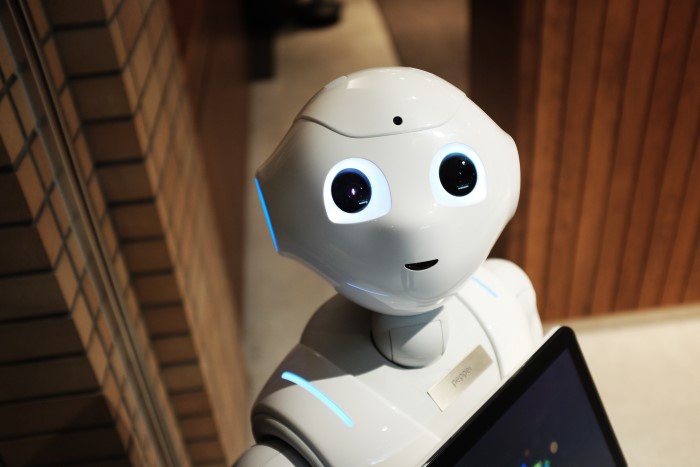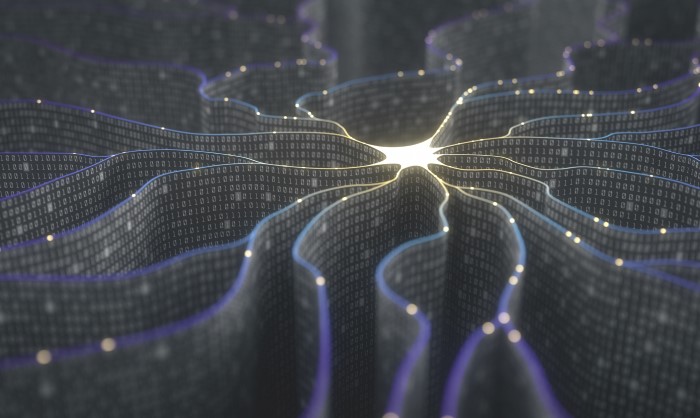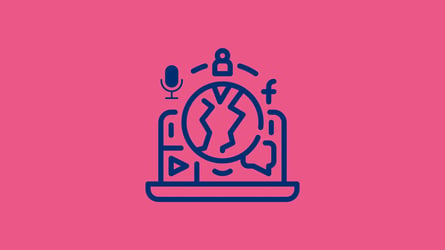Download the definitions of artificial intelligence [PDF]
What does artificial intelligence - AI - mean to you?
Artificial intelligence isn’t just a science fiction thing anymore. The future is now!
Advances in technology and the resulting volume of data that PR and comms personnel have to work with has increased hugely. Big data means we're spending more time managing information, rather than performing actions based on the insights it brings.
In most industries, it isn’t a question of if artificial intelligence should be implemented, but when.
Competition in the information age is fast and fierce. If you’re able to harness the potential of AI, you’ll grab that much needed edge.
There are a heap of artificial definitions in this glossary. As more phrses, words, acronyms, etc., are introduced, I'll add them. Yep, it's gonna grow like mould on last year's pizza.
Artificial intelligence definition
When did artificial intelligence first make the news?
It was introduced as a term in 1956, as part of the Dartmouth Workshop. It describes a computer that reproduces human functions. For example, learning or problem-solving.
In the field of computer science, it’s the study of intelligent agents (IA). A device that observes its environment, and takes action to achieve its goals. AI systems are developed to learn from human instruction, completing specific tasks independent of external intervention.
As computer systems became more advanced, so did artificial intelligence. Able to handle increasingly complex tasks and developing the ability to learn. Wow!
AI is a hugely popular field of science. We have preconceived ideas about it. Quite often, before we've grasped the facts.
My glossary of artificial intelligence definitions will help you separate fact from science fiction. Take a look. You'll be an expert in AI in no time.
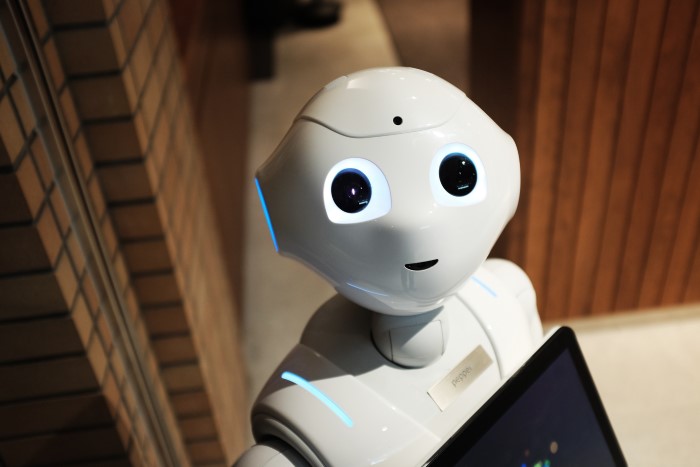
Artificial intelligence definitions
Abductive reasoning
The analysis of a statement or situation by AI. Finding the simplest and most likely explanation for it.
Example: You see that the roads are wet. The most likely hypothesis is… rain. It’s the obvious explanation.
Action selection
Denotes the step an artificial intelligence can or will decide to take in a specific process.
Example: You’re driving as it starts to rain. What do you do next? Turn on the windshield wipers. Clearly.
Algorithm
A set of defined instructions for a sequence of simple or increasingly complex actions to be performed. Actions could be a calculation, the processing of data, or automating repetitive tasks.
Adaptive algorithms take this a step further and can adapt to any changes of information.
Artificial intelligence (AI)
Machines designed to be able to learn, solve problems, and complete tasks with human thought processes as a template. AI was developed to enable the automation of complex but increasingly repetitive tasks. Tasks that still require a level of decision-making and comprehension. This automation allows us humans to focus on more abstract tasks that a machine is unable to undertake.
Example: A machine learns to quickly recognize and catalog different pieces from an art gallery’s collection. The art curator is free to use the complete catalog to plan new exhibitions and attract more visitors.
Talkwalker is a pioneer of AI marketing and PR tools, focused around the Talkwalker AI Engine.
Artificial neural networks
Research and development of technology using the human brain as a model for building more efficient and accurate machine learning systems.
Backpropagation
This is a process typically used to train deep neural networks and refine the results of artificial neural networks. Information is processed by the system and results are sent back up the pipeline in reverse order for verification.
Bicentennial Man
Bicentennial Man is a 1999 science-fiction film based on an Isaac Asimov short story. It stars Robin Williams and Sam Neil, directed by Christopher Columbus. It's the story of a robot butler that becomes self-aware, and its heartwarming journey to becoming more human. Kind of Pinocchio meets AI.
Can't have a glossary of artificial intelligence definitions without some movie references.
Big data
An artificial intelligence definition used to describe the increasing growth of data. Big data requirements are usually beyond the capabilities of commonly used software tools. Requiring new considerations for the circulation, collection, storage, and analysis of the data.
Chatbots
A chatbot - A.K.A. artificial conversational entity (ACE), chat robot, talk bot, chatterbot, chatterbox - is an AI program that imitates human conversation.
Automating a business process, they’ve become popular for basic customer service, instant messaging, and as intelligent, virtual assistants.
Here are some real-life examples:
- Endurance - a robot-companion for older people and sufferers of Alzheimer.
- Casper’s Insomnobot 3000 - a bot for insomniacs to chat with, to combat loneliness.
- eBay eCommerce chatbot - built for Google Assistant so you can use with Google Home or on your phone. The bot will help you buy anything in the world, cheap.
- 1800Flowers - a flower delivery company using a Facebook Messenger chatbot. 1800Flowers claim that 70% of orders received on the bot, came from new customers.
Next time you use live chat customer support, ask yourself… am I talking to a human or a bot?

Artificial intelligence chatbots - Too much caffeine? Can't sleep? Casper will keep you company.
Computational learning theory
This is the field of artificial intelligence research focused on the design and analysis of machine learning algorithms.
Computer vision
A field that deals with how computers find, process, and analyze digital images. Computer vision powers emerging technologies, including facial recognition, augmented reality, and image recognition.
Take a look at Talkwalker’s proprietary image recognition technology to learn more about what can be achieved. It's pretty awesome.

Talkwalker's AI-powered image recognition technology - Where’s the Green Tea Kit Kat at?
Cognitive computing
Technology based on the research of human thought processes. Developing ways of improving the efficiency of AI and computers.
Data mining
The process of discovering patterns in immense volumes of data, or big data. Achieved by utilizing a combination of AI, machine learning, and database systems.
Example: Think about Sherlock’s mind palace. A technique used by the great detective, to access and decipher vast amounts of knowledge from memory recollection alone.
Data science
This artificial intelligence definition describes the field of study dedicated to extracting knowledge and insights from data, using scientific methods, processes, algorithms, and systems.
Deep Blue
An IBM supercomputer built in 1997 to play chess. Designed with the objective to beat, which it famously did, then world-chess champion and grandmaster Garry Kasparov. Seen at the time as a milestone in artificial intelligence development.
Deep learning
Deep learning is the furthest evolution of AI at present. It learns by example and uses multiple layers of nonlinear processing units to achieve phenomenal results. Check out Liesa's blog post on AI and Deep Learning at Talkwalker.
It requires a huge amounts of computer processing power and labeled data, to understand the task at hand. But, it can achieve the highest levels of data accuracy. The Talkwalker AI Engine is an example of deep learning.
Digital Assistants
Also known as Virtual Assistants. Anyone with a smartphone will know them as either Siri, Google Assistant, Cortana, or Alexa. Designed to respond to natural language input from a user, they enable hands-free operation of smartphone functions simply by talking to it.
Example: Siri, what’s the weather like? OK, Google, set my alarm. Alexa, play me some music. Overcomplicated or existential questions generally, return sarcastic remarks.
Expert system (ES)
This is an artificial intelligence system that is designed to replicate the decision-making capabilities of a human expert. It's a combination of two items. A knowledge base, made of pre-established facts and rules. And an inference engine, that applies the rules to known facts to establish new facts. They’re able to solve specific problems from referencing a library of available knowledge.

Artificial intelligence definitions - expert know-how collected and available at your fingertips.
Generative adversarial networks
A pair of joint neural networks trained together to improve data accuracy through competition. One network creates new examples as the other tries to challenge the examples created.
Human-computer interaction (HCI)
HCI is focused on the actions between people and computer technology. A mix of design, psychology, and computer science, it’s a discussion of how humans and computers interact.
Image recognition
Image recognition technology is designed to recognize logos, people, animals, scenery, or objects. Similar to optical character recognition (OCR), it converts an unusual data source into tangible results.
The Talkwalker AI Engine incorporates our proprietary, AI-powered image recognition technology. Brands can find actionable consumer insights, anticipate a crisis, and measure brand awareness. With the ability to recognize over 30,000 brand logos, plus objects and scenes.
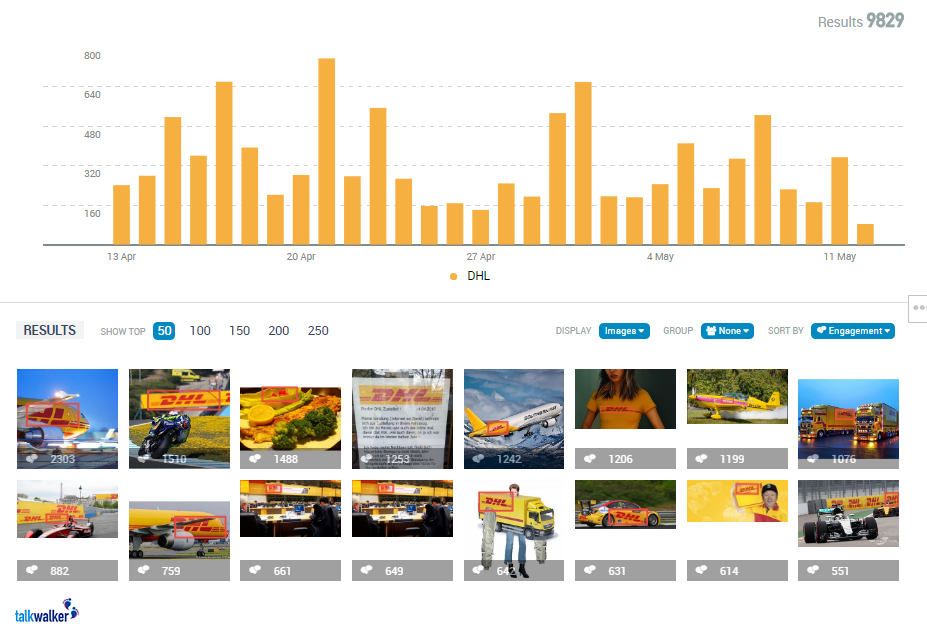
DHL brand presence check-up. Powered by Talkwalker's AI-powered image recognition technology.
Intelligent agent
AI that perceives its environment through sensors, and then acts upon that environment. These AIs could be as complicated as recognizing different faces, as some smartphones do. Or, as simple as a light sensor that detects the light in its environment, and reacts accordingly.
Internet of Things (IoT)
Technologies revolving around the connectivity of different devices with the internet and networks as a medium. Examples being the sharing of documents across devices with cloud computing. For instance, using an app to remotely turn on your lights at home while you’re away on vacation.
Isaac Asimov
Influential science fiction author and biochemist from the United States. He is credited by Encyclopedia Britannica with having written or edited about 500 volumes in the genre since 1939. Asimov created the ‘Three Laws of Robotics’, a set of basic ethics dictating that a robot:
- May not injure a human being, or, through inaction, allow a human being to come to harm
- Must obey the orders given to it by humans except where such orders would conflict with the first law
- Must protect its own existence as long as such protection does not conflict with the first or second law
The laws remain a point of reference in modern science fiction. Often used in academic discussions relating to robotics and artificial intelligence.
Let's be honest, no glossary of artificial intelligence definitions would be complete with an Asimov mention.
John McCarthy
A computer scientist at Stanford, John McCarthy was an influential figure in the field of artificial intelligence. Credited with being one of the founders of AI as a field of study and for coining the term ‘artificial intelligence’. He developed the language commonly used in artificial intelligence programming, Lisp.
Johnny 5
The central character from the 1986 science fiction comedy film Short Circuit. A military robot that becomes self-aware after being struck by lightning.
I seriously don't recommend this as a way of training AI.
Lisp
Short for List processing. A programming language developed in the late 50s. The basis for various programming languages, Common Lisp, Standard Lisp and more, are widely used in artificial intelligence development today.
Machine learning
This is the process of AI improving themselves from experience - learning - without explicit programming. Often, the artificial intelligence will have access to data and use that data to learn for themselves.
In the case of Talkwalker custom models, the AI begins the process of learning, through human training. Once trained, it can look for data patterns, and make decisions based on examples that have been added.
Nadella’s rules for AI
Microsoft CEO Satya Nadella recently wrote an article published on The Slate addressing AI research. In it, he discussed certain big picture “principles and goals" related to the field of AI. Issues he thinks are important to consider as research and development of the field progresses. He states that considerations should be made on how AI stands, with regard to affecting our lives and society in future.
Natural language processing (NLP)
The use of machine learning methods to allow computers to learn and understand natural spoken or written language. It's essential to Talkwalker’s sentiment analysis.
Optical character recognition (OCR)
The conversion of printed or handwritten text, for example from scans, PDFs, or photos of documents, into computer-encoded text. It’s used for digitizing text, so it can be used for data analytics purposes.
Pattern recognition
The branch of machine learning that focuses on detecting patterns or regularities in data, to aid with data classification.
AI tools help us see the big data picture.
Predictive analytics
Also referred to as predictive modeling. Uses the analysis of past data, to form a prediction of future outcomes. A combination of machine learning, statistics, and data mining. It can help brands predict brand issues, or detect relevant trends - in real-time.
R2-D2
Affectionately known as Artoo Detoo. Iconic robot or more precisely ‘astromech droid’ from Star Wars. Main functions included emergency starship repairs, emotional support, and comedic relief. Originally voiced by Ben Burtt, who later become the voice of another AI persona, WALL-E.
It's my list of artificial intelligence definitions. I'll include whatever I like.
Reinforcement learning
Reinforcement learning is a type of machine learning with less specific goals. Instead, the goals are more abstract, such as “maximize brand mentions.” During training, the AI learns by acting towards the goal and evaluating its contribution after each effort.
Robot
Originally defined as a “device that automatically performs often repetitive tasks”. The concept was conceived by Karel Capek, based on the Czech word ‘robota’ meaning, compulsory labor.
Sentiment analysis
Combination of natural language processing (NLP), computational linguistics, and text analytics. Applied together to identify and extract subjective information from content. Its goal is to understand the attitude of a person.
Talkwalker’s sentiment analysis is powered by the Talkwalker AI Engine. It interprets the sentiment behind brand mentions on social media, news and blog sites. It can even detect and translate difficult to understand phrases, like sarcasm, with an overall accuracy of 90%.
Share of eye
Similar to share of voice, this is a way to measure your brand presence with regard to images. It shows how your brand images are being shared by your consumers, compared to images of your competitors.
Image recognition is essential for this method. It helps quantify your brand value and the ROI of your campaigns and event sponsorship.
Speech recognition
The ability of a machine to interpret natural human speech patterns, and translate them into a machine-readable format. Also known as automatic speech recognition (ASR), computer speech recognition and speech to test (STT).
Example: Technology behind virtual assistants such as Siri and Alexa, enabling them to understand voice commands.
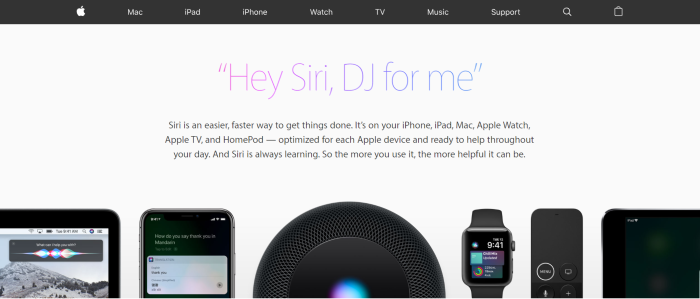
Siri, I just want to dance.
Strong or weak AI
The ultimate goal of a strong AI is to think independently and perform an intellectual task that a human could.
The opposite of this would be a weak or narrow AI. This is an AI technology focused on one specific task, with no aim to expand further. Most AIs in use at present would be classed as weak.
Supervised/unsupervised learning
Supervised and unsupervised learning are two different AI training methods. Supervised training, includes labeled data sets. This allows the artificial intelligence to learn from the expected labels, and extrapolate that into wider data sets.
Unsupervised learning requires no labeling, and it's up to the AI to self-categorize its output. While unsupervised learning can perform more complex learning functions, it can also create unnecessary or complicated categories of data. Giving more clutter, rather than less.
The custom models in the Talkwalker AI Engine uses supervised learning.
Transfer learning
An algorithm trained to build knowledge relating to a task. The knowledge gained is then applied to complete a different, but related task. For example, you could train an algorithm to recognize images of cars. It could then transfer that knowledge to recognize similar vehicles, such as trucks.
Turing test
Developed by Alan Turing in the 1950s. The Turing test was devised to see if people could distinguish between machine or human interactions. The standard interpretation is to have an interviewer blind-question both a human and a computer. Then see if the interviewer can accurately predict which subject is the AI based on their results.
Vision processing unit (VPU)
A vision processing unit (VPU) is a kind of microprocessor that accelerates machine learning and AI technologies. Built to support tasks such as image processing and image recognition.
Watson
An IBM supercomputer combining AI and analytical software to create a question-answering computer system. It has the ability to answer questions posed in natural language. Watson was named after Thomas J. Watson Sr., IBM’s first CEO.
That's it. Done. Finished. Phew!
Download the definitions of artificial intelligence [PDF]
What’s the future of artificial intelligence?
There you have it, with my glossary of artificial intelligence definitions, you’ll be up to speed.
Our data science team is constantly hard at work, keeping us at the cutting edge of AI. Give us a click and get a free demo - see our artificial intelligence in action.

